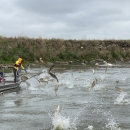In July 2011, the Aquatic Nuisance Species Task Force (ANSTF) re-established the Recreational Guidelines Committee (Committee) composed of 55 Federal and State agency, non-profit and industry representatives. The Committee’s mission is to update the 2000 ANSTF Recommended Voluntary Guidelines for Preventing the Spread of Aquatic Nuisance Species Associated with Recreational Activities (Federal Register/ Vol. 65, No. 76/ Thursday, April 13, 2000/ Notices, Pg. 19953). Those guidelines were revised taking into account new aquatic invasive species invasive species
An invasive species is any plant or animal that has spread or been introduced into a new area where they are, or could, cause harm to the environment, economy, or human, animal, or plant health. Their unwelcome presence can destroy ecosystems and cost millions of dollars.
Learn more about invasive species (AIS), and new recreational activities and equipment. Guidelines were revised for six recreational activities: anglers, motor boaters, non-motorized boaters, scuba divers and snorkelers, seaplane pilots, and waterfowl hunters.
Publication date
Type of document
Guidance
Program


